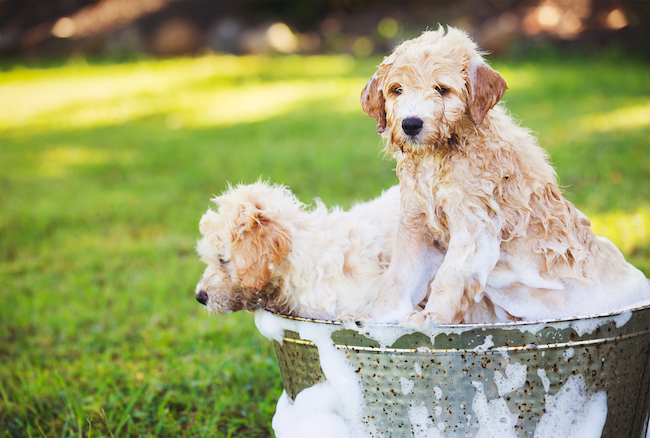
When a pup goes running or walking through poison ivy, poison oak, or sumac bushes, the exposed skin of the under belly and inner legs, brushes by the foliage and plants in his path. Once the oil from sumac leaves or poison ivy and poison oak penetrate the skin, the dog would get infected. Fortunately, these case do not occur very often as a dog’s coat offers a fair amount of scalp protection. However even though a case is not likely, that does not mean infections do not occur. And some cases are so mild that the pet owner might not become aware of it immediately, especially if the dog scratches his skin often, or if he has other epidermal ailments.
Poison Prevention
One of the upsides of urushiol (the infecting oil on these plants) is that it takes a while to be absorbed into the skin. A good way to protect your dog from any possible infection is to wash him immediately after the supposed exposure. (This is particularly important as the oils from poisonous leaves can also cling to the dog’s fur, which can then be passed to human legs, hands or furniture and upholstery.
Humans are more threatened by canine plant exposure than the dogs actually are.
Ways to Prevent Infection
- Try not to pet your dog or let him rub against you until you are able to clean off any lingering poison ivy/oak/sumac residue from his coat.
- When you get home, put your dog outside (away from the furniture/carpet indoors).
- Remove all your clothes (keeping them separate from your regular laundry pile) and put them in the wash right away.
- Take a shower, and scrub your skin thoroughly at least twice, using strong soap.
- Once you are clean, go outside and put your dog’s leash, collars, and harness into a bucket with soap and water to soak.
- Wear rubber dish gloves and long sleeved shirt to protect your skin, while you wash your dog thoroughly at least twice. (Be sure to wash the towel you dry your dog with, and finish rinsing the soapy leash, collar or harness when you are done. Hang these up to dry.)
Treating Poison Ivy, Oak and Sumac
When a person is infected by one of these plants, some using rubbing alcohol to clean the blisters and dry them out. This can be harsh on the skin, so calamine lotion (caladryl) is usually the method of treatment preferred by many. Though the blisters and rashes are uncomfortable and can cause someone to be house-bound for a few days, the problem seldom escalates into a severe condition.
In the rare circumstance that your dog gets infected with a poisonous rash on his skin, do not treat the red patches with calamine lotion. This can be toxic for a dog, especially as the itchiness may incline him to lick the wounds, which if covered by calamine lotion, would subject him to poisonous zinc oxide consumption. It would be better to call an emergency health advisor/hotline, or take your dog to the vet where he may be prescribed anti-inflammatory medication to reduce swelling and itchiness.
Note: Canines experience many skin issues such as allergies, rashes, dryness, and irritation, for an abundance of reasons. If you are uncertain about your dog’s symptoms and are worried he may have an illness or poisonous infection, make sure to speak to a veterinarian or another domestic pet healthcare professional.

